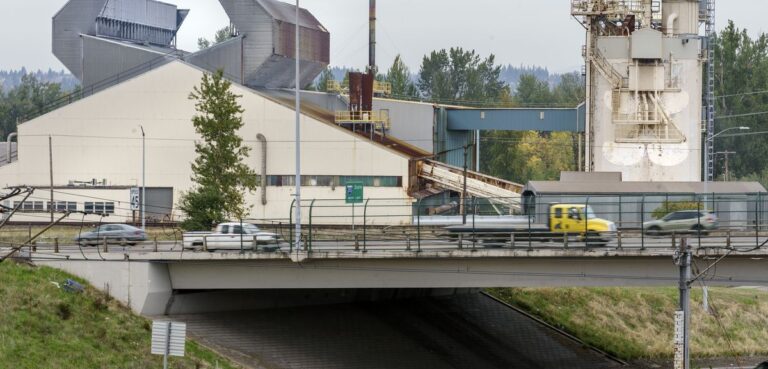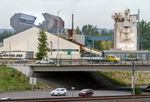
A glass recycling facility in Northeast Portland has committed to installing air pollution control technology after reaching an agreement with state regulators following multiple air quality violations.
Owens-Brockway, located near the Cully and Sumner neighborhoods, said it will install a catalytic ceramic filter, to control and reduce particulate matter, nitrogen oxide and sulfur dioxide emissions. The technology must also ensure compliance with the facility’s modified permit limits for particulate matter and reduce those emissions by 95%.

According to a recent air modeling study, the Owens-Brockway glass-recycling plant is releasing harmful amounts of pollutants and threatening the health of nearby Northeast Portland neighborhoods of Cully, Sumner and Maywood Park.
Kristyna Wentz-Graff / OPB
This comes as Owens-Brockway was fined by the Oregon Department of Environmental Quality more than $1 million last June for multiple, ongoing air quality violations of particulate matter emissions as well as permitted opacity. The facility melts down used beer and wine bottles in furnaces to create new glass containers. On average, the facility recycles more than 240,000 pounds of glass a day.
According to the Environmental Protection Agency, breathing particulate matter can lead to several health effects including respiratory problems like asthma, coughing and difficulty breathing. It can also lead to irregular heartbeat, nonfatal heart attacks and heart or lung disease. Nitrogen oxide and sulfur dioxide can lead to similar health problems.
DEQ’s Cleaner Air Oregon manager Matt Davis said the agency’s enforcement only required the facility to reduce its particulate matter emissions. But Davis says the filter will help reduce other pollutants, like nitrogen oxide and sulfur dioxide, that weren’t required to be regulated.
“Ultimately, it’s a good thing that their device is going to achieve what we are requiring it to do and go beyond a little bit,” he said.
Last fall, DEQ reached an agreement with the facility and offered two options, either shut down its glass-making furnace or install pollution control technology.
In a press release, O-I Glass, Inc. parent company of Owens-Brockway said it’s investing $11 million in its Portland facility to “advance the environmental performance of its glass packaging operations, upgrade the plant with advanced technology and prepare for future growth.”
The company expects the installation of the new air quality control equipment for its furnace to be completed by April 2024.
Environmental groups are calling the decision to install the filter a major public health victory for the surrounding communities.
“We are relieved that our advocacy efforts have resulted in holding a bad actor in our neighborhood accountable,” Verde’s director of strategic partnerships Vivian Satterfield said.
Last year, residents from the Cully neighborhood, several environmental groups, and public-interest environmental law organization Earthjustice, called on federal and state regulators to implement stricter air quality rules and hold Owens-Brockway accountable for pollution in nearby neighborhoods. The Cully neighborhood is one of Portland’s most racially diverse neighborhoods where more than half of the residents are people of color and 23% of its residents are Latino.

Wendi Suni Yah Canul poses with her children Mario Valle Yah (6) and Kiara Edila Valle Yah (8) with the Owens-Brockway glass recycling facility in the background in Northeast Portland’s Cully Park on Oct. 7, 2021.
Monica Samayoa / OPB
Satterfield said she’s grateful for the Cully residents who spoke up about their concerns about what they were seeing and smelling in the neighborhood. Satterfield said many residents were complaining of an odor in the air and on their children’s clothes after playing outside. Some residents reported noticing soot and residue.
“The more we discussed with them and realized we did have high rates of asthma in our community led us to partner with organizations that we knew had some of the technical components and expertise in order to further investigate what residents were already flagging for us early on,” she said.
Satterfield hopes community members feel relieved and have learned that advocacy efforts do work despite taking some time to achieve their goals.
“I think this really shows the compelling grounding in people power in order to not let heavy industry, not let the bureaucracy just operate with the status quo,” she said.
Earthjustice commissioned a study that found Owens-Brockway was emitting high levels of nitrogen oxides and sulfur dioxide into surrounding communities, potentially exceeding federal air-quality standards even after the facility reduced its operations to just run one of its four furnaces.
“It has taken years, but this announcement is a significant step forward for addressing the harmful air pollution affecting the vibrant and culturally rich communities neighboring Owens-Brockway,” Earthjustice attorney Ashley Bennett said in an emailed statement. “We will continue to closely monitor the facility’s progress to reduce air pollution and support community advocates in ensuring that Owens-Brockway installs the most health-protective pollution controls.”
DEQ will review Owens-Brockway’s submission to add the filter device and will have a public hearing and comment period. After those are complete and the application is approved by DEQ, the facility will then have 18 months to complete the construction of the filter device. It is currently operating under an interim opacity limit as the agency is still modifying its air quality permit.